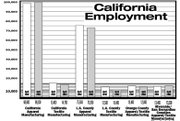First Quarter Report: Mixed Signals Cloud California Forecast
Southern California’s economy is playing the waiting game.
The war in Iraq is over. Housing construction is up. But consumers and business investors still are not spending money the way they used to.
Consequently, economists predict the local economy will not improve until late 2003 or early 2004. This lackluster forecast comes on the heels of a mixed first quarter in Los Angeles County.
Container traffic at the ports of Los Angeles and Long Beach was up a little more than 14 percent during the first three months of this year, but the travel and tourism industries were hard hit by the war and the spread of severe acute respiratory syndrome (SARS). Domestic and international passenger arrivals at Los Angeles International Airport were down 8.18 percent in March, compared with March 2002.
“The economy is not bad, and it’s not good,” said Christopher Thornberg, senior economist with the UCLA Anderson Forecast, a research agency affiliated with The Anderson School of business at the University of California, Los Angeles. “Things have been steady in Southern California. The unemployment rate has actually gone down half a percentage point in the last year.”
In April, the Los Angeles County unemployment rate was 6.3 percent, compared with 6.8 percent during the same period last year, according to the California Employment Development Department.
Even though the unemployment rate is inching downward, there have been some soft spots in the local employment scene.
The motion-picture industry, one of the area’s principal economic engines, has seen a decrease in jobs.
“There is still runaway production in Canada,” said Jack Kyser, chief economist at the Los Angeles County Economic Development Corp. (LAEDC), where a weak Canadian dollar keeps production costs low.
In April, there were 8,700 fewer jobs in the motion-picture industry than there were during the same time last year. However, that is a major improvement over March, when there were 17,700 fewer jobs than there were during March 2002.
Manufacturing down, retail mixed
Manufacturing has been in the doldrums too, particularly in the apparel industry.
In April, the number of jobs in the Los Angeles apparel industry declined 6.8 percent to 70,300 jobs from the previous April. The textile industry saw a 16.8 percent drop to 10,400 jobs in April.
On the retail front, sales at stores have been mixed. Some have been doing well. Others have been having a hard time pulling in customers.
During the first quarter of this year, retail sales in the West were up slightly more than 4 percent, according to the National Retail Federation.
But big depar tment-store chains, such as Federated Department Stores Inc., have suffered considerably. Federated, parent of department stores Macy’s and Bloomingdale’s, has seen same-store sales decline every month this year. The company’s same-store sales were down 1.2 percent in January, 6.8 percent in February, 6.5 percent in March and 1.4 percent in April.
“It’s a tough market out there,” said Fred Gaylord, senior vice president at Capital Factors Inc., an asset-based lender that deals predominantly with the apparel industry. “With the war and SARS, people have been afraid to shop.”
With an iffy first quarter, the local economy is still looking shaky. No one is predicting there will be a major economic take-off in Los Angeles County before the end of the year.
“You get the sense that we are marking time,” Kyser said. “The good news is that the Iraqi war is behind us. But there is nervousness about SARS and concern in California about high workers’ compensation rates.”
SARS fallout, escalating debt
Esmael Adibi, director of the A. Gary Anderson Center for Economic Research at Chapman University in Orange County, said several factors will affect whether Los Angeles County emerges sooner or later from its economic stagnation: consumer spending, business investment, government spending and growth of the export market.
“We don’t see any boost in any of these sectors before the end of the year,” Adibi said. “We’ve seen some weakness on the consumer side, so that won’t be a major driving force. State government, with the budget crisis isn’t going to be a big spender. So business investment is our big hope. Obviously, there is some pent-up demand in terms of business to invest, but the pessimism on the part of CEOs prevents them from increasing their spending in a significant way for the remainder of the year.”
SARS is the wild card in predicting the economic future for the apparel and retail industries, according to economists. Many clothing manufacturers are continuing to produce goods in China and other Asian countries. But few apparel executives or clothing designers are traveling overseas.
“The biggest threat to the apparel industry over the next three months is the SARS thing,” said Thornberg of the UCLA Anderson Forecast.
Another problem is increasing consumer debt. With mortgage rates at near record lows, there has been a big demand for houses. The number of new housing permits in Los Angeles County climbed 50.5 percent to 5,084 during the first quarter over the same period last year, according to the LAEDC. But with consumers taking on more debt buying new homes, they may find themselves with less disposable income to spend on apparel and other items.
“People are becoming saturated with debt,” Thornberg said. “They will eventually have to cut back on purchases to service all that debt. That means weaker demand for luxury goods.”
T-shirts, socks and underwear purchases will abound, but economists do not predict that $300 cocktail dresses will be flying off the racks.






















